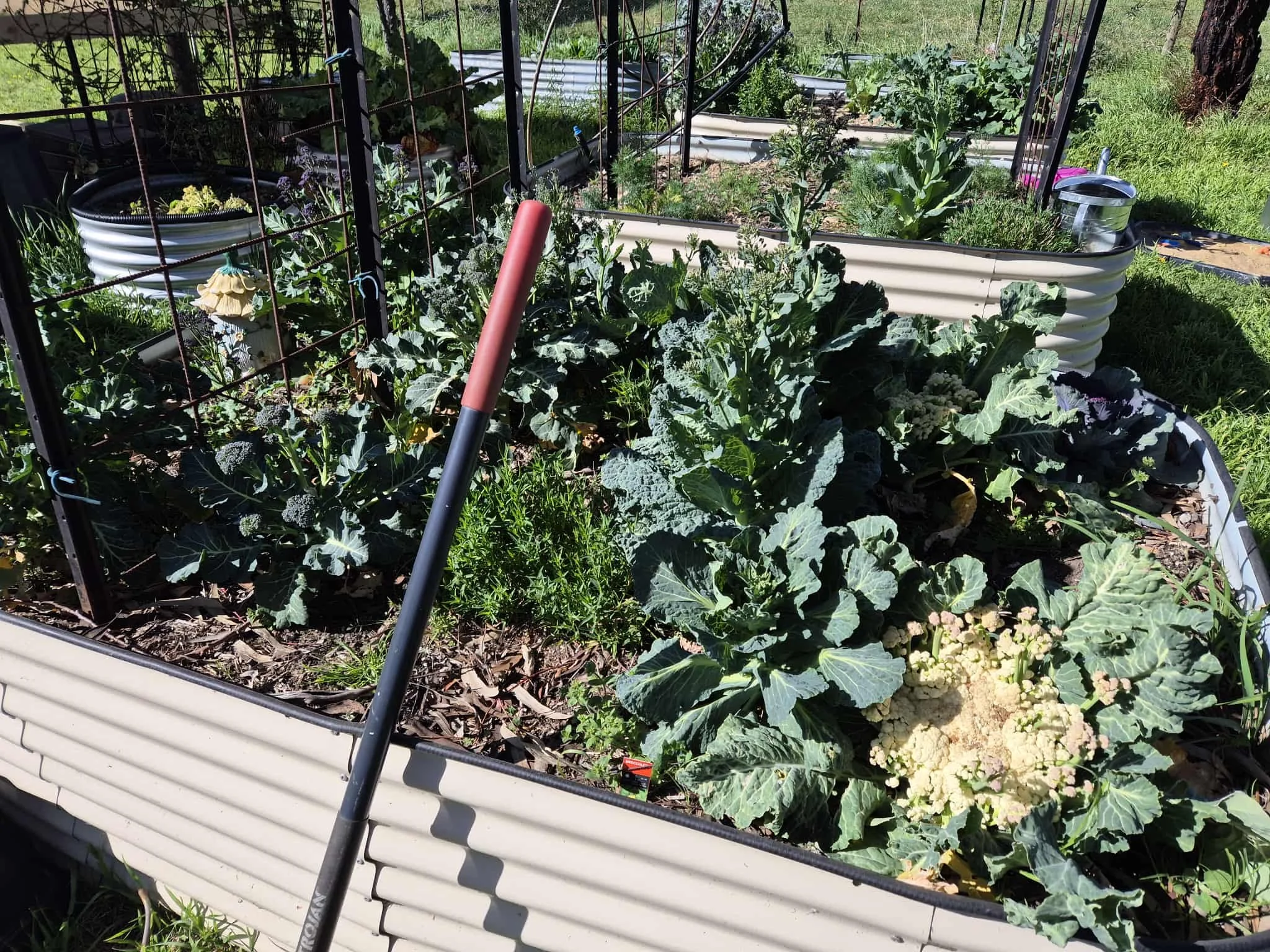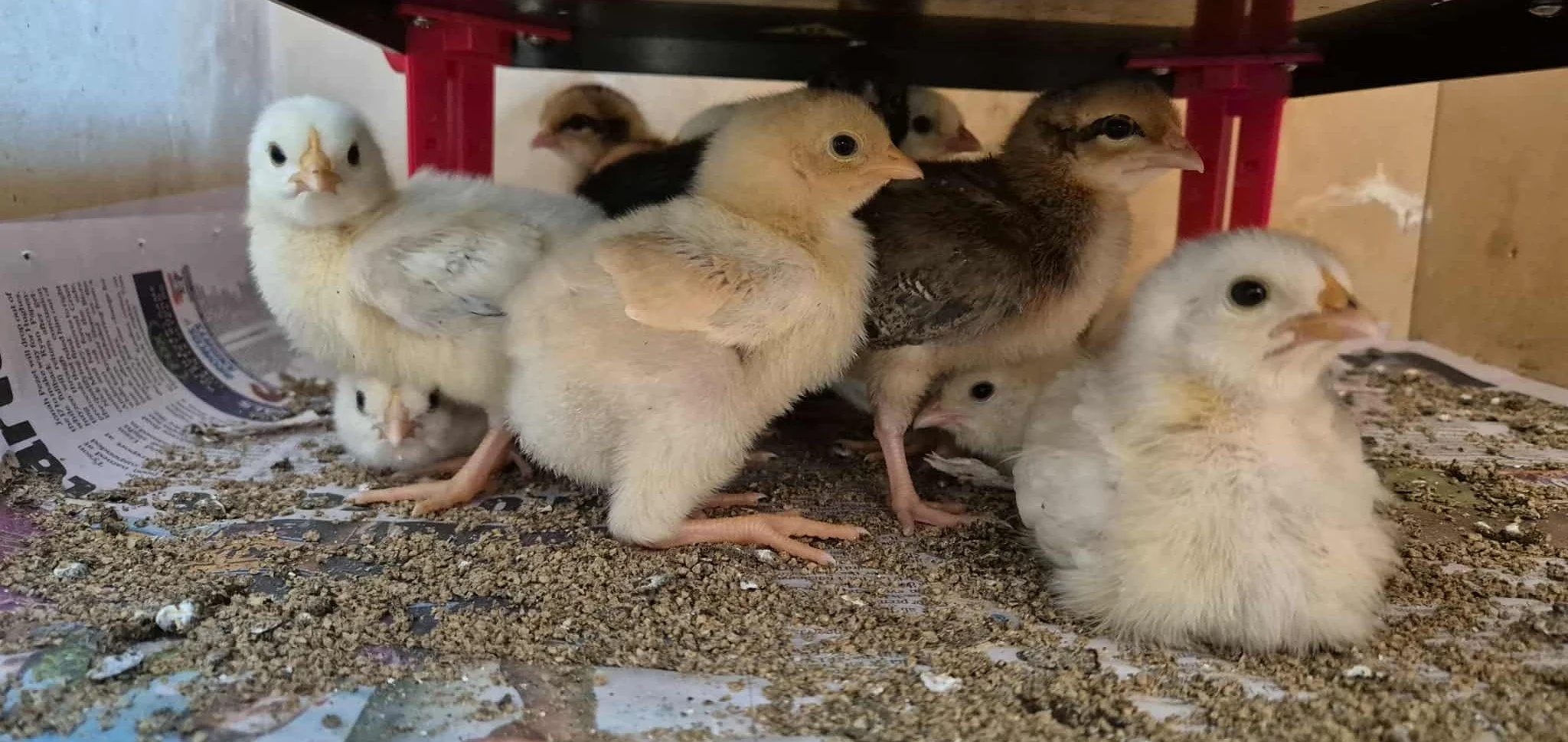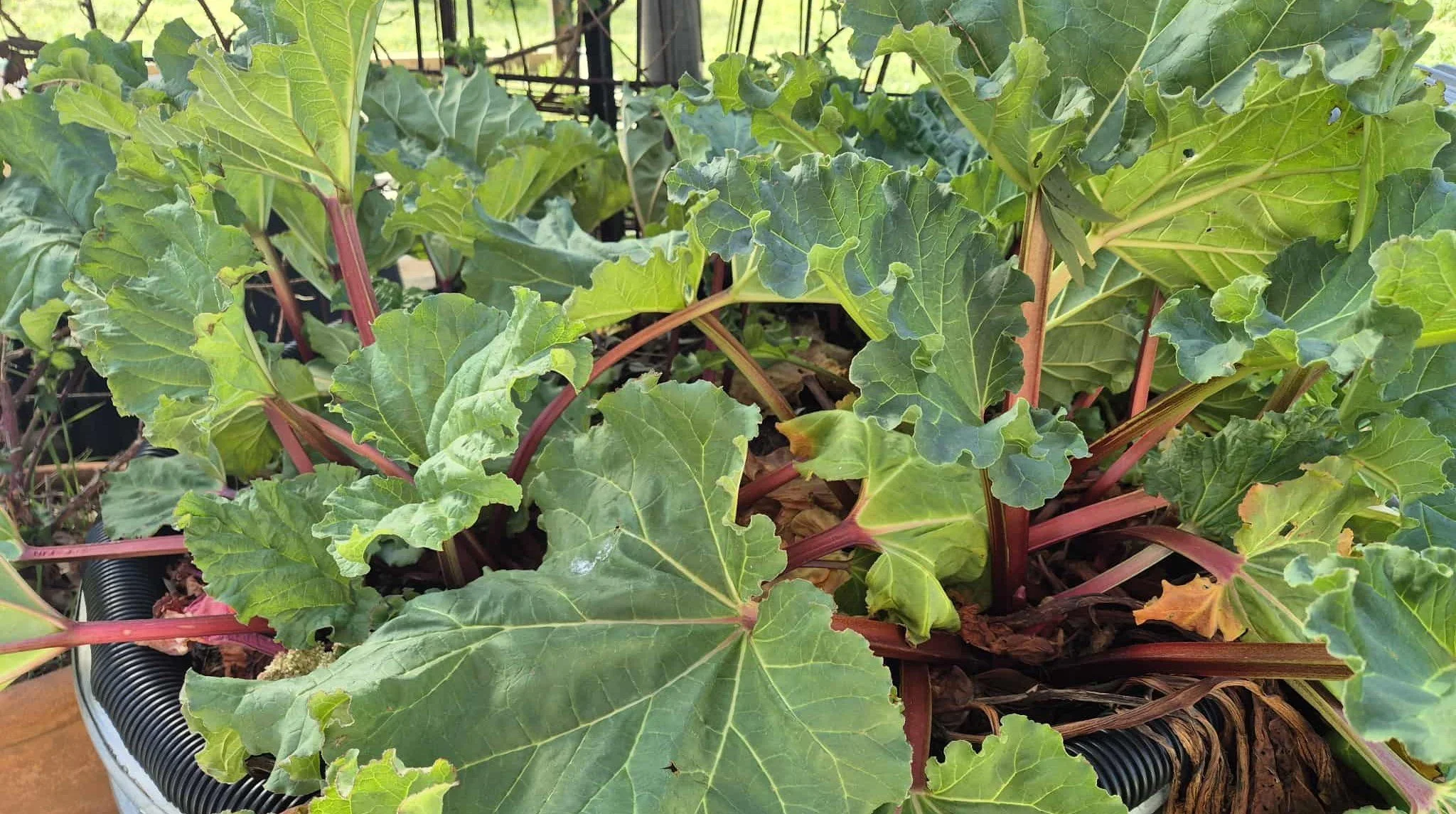Our Cold Climate Garden Journey : From Killing Trees to Growing 60% of Our Food
Discover a new episode of the Conscious Living Podcast - Now LIVE
When we loaded up the moving truck in December 2019 and headed from Wagga Wagga to Bungendore, we were full of confidence about our food-growing abilities. We'd spent years practicing permaculture, turning our tiny 500m² rental into a productive paradise, and mastering the art of warm-climate gardening.
We thought the move to a bigger block with our own land would simply mean more space to do what we already knew how to do.
We were spectacularly wrong.
The Wagga Years: When Everything Was Easy
In Wagga Wagga, we had it good. The climate did most of the heavy lifting for us. Long growing seasons meant you could plant early and harvest late. Mild winters meant frost wasn't a constant threat. You could get away with forgetting to mulch or planting a bit too early, and things would still work out.
We filled our small rental block with potted fruit trees, herbs, veggie beds, and compost bays. Everything flourished year-round without too much effort. We became confident, maybe overconfident, in our ability to grow food.
Looking back now, the climate was forgiving enough that we didn't have to be particularly skilled. We just had to show up.
The Bungendore Reality: A Complete Reset
Moving to Bungendore in the Canberra region gave us nearly 1,650 square meters of our own land. More space, more possibilities, more control. But it also brought winters that were longer and harsher than anything we'd experienced. The wind cut straight through the property, and frost didn't just show up in winter. It stuck around through spring, sometimes all the way to November.
Everything we'd learned in Wagga suddenly needed rethinking.
Before we could even think about planting, we spent months just trying to understand the site. Where did the sun hit first in the morning? Where did frost linger longest? How could we carve out protected spots in what felt like a wind tunnel? The block itself wasn't garden-ready either. Fences zigzagged everywhere, rocks covered valuable north-facing areas, and the soil was compacted clay that wasn't exactly fertile.
Our winter veggies have thrived…but we’ve found it a constant battle to keep the aphids away!
The Failures: What We Lost
Citrus Trees: Our Biggest Heartbreak
In Wagga, citrus was straightforward. Plant it, water it, pick the fruit. In Bungendore, we've lost more than 10 citrus trees to frost.
We tried everything:
Planting along eastern fence lines for gentle morning defrosting
Using thermal mass from brickwork to retain heat (the same passive design principles we use in energy-efficient homes)
Wrapping them, covering them, moving them
We have exactly one lemon tree left, tucked away in a back corner. We're not entirely sure why it survived when all the others didn't.
Fig Trees
These beautiful, productive trees should thrive in our climate zone. But Bungendore's persistent frost keeps getting them before they can establish properly.
The Learning Curve
For impatient gardeners like us, learning to wait was tough. We couldn't just plant tomatoes in early spring and hope for the best. They'd be wiped out by frost within a week. The short growing season meant every decision mattered more.
The Unexpected Wins: What Thrives in the Canberra Region
While we were mourning our citrus dreams, we started discovering what absolutely loves Bungendore's cold climate.
The Raspberry Forest
We planted four small raspberry plants thinking we'd have a modest berry patch. Within two years, we had what can only be described as a raspberry forest. They loved our climate, maybe a little too much. That taught us quickly to be more selective about what we put directly in the ground.
But it also gave us something magical. Our kids now turn evening berry hunts into a daily ritual during spring and summer. There's something powerful about watching them discover that food doesn't just come from shops. It grows on bushes in our backyard.
Garlic That Actually Tastes Like Garlic
With those long cold winters providing proper dormancy periods, our garlic is incredible. The flavor is so intense and complex compared to anything we ever grew in warmer conditions. We trial different varieties and types every year, and they keep getting better.
Berries, Brassicas, and Root Vegetables
Berries of all kinds thrive here. Brassicas like broccoli, kale, and cabbage also love the cold. Root vegetables come out sweet and dense. Plants that need a good cold period for dormancy are genuinely happy here.
We realized we'd been fighting our climate instead of working with it.
Our new chickens have arrived! Now to finish the coop before they’re ready to head outside…
What We Had to Completely Rethink
Composting in Cold Climates
In Wagga, our compost bins were magical decomposition machines. Throw scraps in, turn occasionally, and we'd have beautiful compost in a few months.
In Bungendore, everything slows down dramatically in winter. Organic matter just sits there for months, barely breaking down. We adapted by moving to enclosed systems to retain heat better, rotating between multiple bins to keep the process going year-round, and solving our mouse problem with strategic rodent mesh.
Once we figured out the system, it worked beautifully. It's just slower.
Seed Starting Became an Indoor Affair
Those long, gloomy winters in the Canberra region meant we needed to start plants established undercover before the growing season even thinks about starting. We now use mini greenhouses and windowsills to give plants a head start on the short growing season.
Tomatoes, pumpkins, zucchinis, anything frost-sensitive all get started indoors. We don't even think about planting them outside until late October, sometimes November, depending on the year. It means more effort upfront, but the payoff is huge. Plants go in stronger and can cope with whatever the climate throws at them.
Soil Building From Scratch
The ground was compacted, patchy, hard clay. Not exactly fertile. We started building beds using sheet mulching: layering cardboard, compost, manure, and straw, then leaving them to settle for months. It wasn't instant, but it gave us a healthy foundation we could add to over time.
We used what we had: grass clippings, autumn leaves, chicken bedding. We added comfrey and herbs around fruit trees, chopped them back, let them break down into the soil. Over time, the beds became easier to work with and the plants started showing us they were happy.
Strategic Placement and Microclimate Design
We became much more intentional about placement. Using thermal mass, creating protected microclimates, understanding where frost settles and where it doesn't. We added windbreaks to protect delicate areas. We shifted beds to sunnier spots and let go of things that weren't working.
This observational approach mirrors exactly how we assess properties for sustainable home design at Conscious Architecture. We focus on understanding sun paths, wind patterns, and thermal performance before making any decisions.
Building a Permaculture System That Works
As our confidence grew, we started thinking about permaculture not just in terms of layout, but how to make our garden work without constant intervention. That meant planting in layers (trees, shrubs, herbs, ground covers) and choosing plants that supported each other.
Our small food forest now feels like a self-sustaining corner of the garden. It's not perfectly tidy, and it's adapted over time, changed locations, moved about. But it's productive, diverse, and full of life.
We made peace with the fact that we'll never really grow tomatoes like we did in Wagga. But we grow things here that we couldn't have there.
What This Has Meant for Our Family
The garden has become more than just a food source. It's part of our daily rhythm and routine.
The kids know how and when to pick raspberries, which ones are the sweetest, and when the broccoli's ready. We eat seasonally because it makes sense, not because we're trying to prove a point. During summer, we grow about 60% of our fruit and vegetables, supplementing with a fortnightly box from Farmer's Pick (produce that doesn't quite meet the strict aesthetic requirements of major supermarkets but tastes exactly the same).
Our meal planning revolves around what's ready in the garden rather than what's on sale at the shops.
Community Resilience and Sharing Abundance
One of the most meaningful developments has been how food growing became connected to community resilience in Bungendore, especially during cost-of-living pressures.
When your raspberry forest produces more than your family can possibly eat, sharing feels obvious. We started sharing excess produce with local Bungendore cafes and neighbors. In return, we received eggs, homemade preserves, and other garden surplus. It's created an informal network of food security that goes beyond just our household.
This approach to building resilience through community connections complements our philosophy at Conscious Architecture of designing homes that reduce running costs and increase self-sufficiency.
Rhubarb is one of the many things we share with our local community, and it absolutely thrives!
Key Lessons for Cold Climate Gardening in the Canberra Region
1. Focus on What Thrives, Not What You Miss
We spent too much energy trying to make warm-climate plants work when we should have been exploring cold-hardy varieties that naturally thrive here. Observation beats stubbornness every time.
2. Expect a Multi-Year Learning Curve
The first year, you're figuring out basics. The second year, you're adjusting. By the third or fourth year, you're starting to really understand your property's unique microclimates and conditions.
3. Observation Is Everything
Watch the shadows. Watch the frost. Watch where the sun moves through the day. Pay attention to what thrives and keep a notebook. Cold climate gardening is specific to your site, your soil, and your conditions.
4. Start Small and Build Systems
Stop aiming for perfection and start building a system that works. Small steps count: one seed tray on a windowsill, one wheelbarrow full of compost, one raised bed working better than last year. It all adds up.
5. Connect with Local Knowledge
Every region has plants that love local conditions, techniques that work specifically there, and varieties adapted to local challenges. The Bungendore and broader Canberra region gardening community has been invaluable in sharing what actually works here.
6. Be Prepared to Lose Plants
It's not failure. It's data collection. Every plant that doesn't work teaches you something about your environment.
7. Patience Is Non-Negotiable
In a world that moves fast, growing food in a cold climate is the opposite. You can't rush it. You have to plan, adapt, and work with the seasons, not against them. And because of that, the wins feel bigger.
A ripe tomato isn't just a tomato. It's the result of attention, tuning in, and showing up even when it's cold and inconvenient.
What Conscious Living Really Means
This experience has deepened our understanding of what conscious living actually means in practice, both in the garden and in the homes we design.
It's not about imposing some ideal system onto your environment. It's about observing, adapting, and finding ways to work with the conditions you actually have rather than the conditions you wish you had.
At Conscious Architecture, we apply these same principles to creating energy-efficient, people-centered homes in Bungendore and throughout the Canberra region. Just as we learned to work with our cold climate for food production, we design homes that are responsive to their site and conditions, responsible in their construction and carbon footprint, and resilient in their longevity and ability to perform well over decades.
For us, conscious living means minimizing environmental impact while maximizing self-reliance. It means understanding that food miles, seasonal eating, and energy efficiency are interconnected ways to reduce our footprint. It means thinking in cycles rather than linear consumption, whether that's composting kitchen scraps or designing homes built to last. And it means building resilience through self-sufficiency in food production and low running costs in home energy use.
When supply chains are disrupted or food and energy prices spike, even partial self-sufficiency makes a real difference to both household budgets and our sense of security.
The Bigger Picture
Growing food in Bungendore's cold climate has taught us that conscious living isn't about having perfect systems or getting everything right. It's about staying curious, being willing to adapt, and building resilience through understanding rather than control.
We're still learning, still losing some plants and being surprised by others. The cockatoos are winning the war for our orchard fruit, and we're learning to share with wildlife as well as neighbors.
But our kids are growing up understanding that food security comes from understanding your environment, not from controlling it. They've learned that resilience comes from adaptation and community connections, not from forcing systems that don't fit.
Start Where You Are
Whether you're growing on a balcony, in a backyard, or on a windswept block like ours in the Canberra region, the key is to start where you are. Observe, adjust, celebrate the small wins, and trust that with time you'll find your rhythm.
Even in the cold.
It's not about doing everything perfectly. It's about observation, adaptation, and creating systems that suit your space and your life.
Listen to the Full Episode
Want to hear the complete story with all the details, failures, and lessons learned? Listen to Episode 104 of the Conscious Living Podcast: Our Cold Climate Garden Journey (From Killing Trees to Growing 60% of Our Food).
Listen on Spotify | Listen on our website | Listen on YouTube
Ready to Design Your Energy-Efficient Home in the Canberra Region?
Just as we've learned to work with Bungendore's climate for food production, at Conscious Architecture we design homes that work with your site, your lifestyle, and your budget.
Whether you're building new, renovating, or looking to improve your existing home in Bungendore, Braidwood, or across the Canberra region, our integrated approach combines thoughtful, site-responsive design with in-house energy assessments to create comfortable, cost-effective, sustainable spaces built to last.
Ready to start your project? Book a free 30-minute discovery call and let's discuss how we can create a home that works for you, your site, and your future.
Alternatively, you can call Brent on 0439502853 to discuss your home's specific needs.
Have you made a climate transition with your garden? What were your biggest challenges and wins growing food in the Canberra region?
We'd love to hear your story. Tag us @conscious_arch_studio or just pop me an email!




